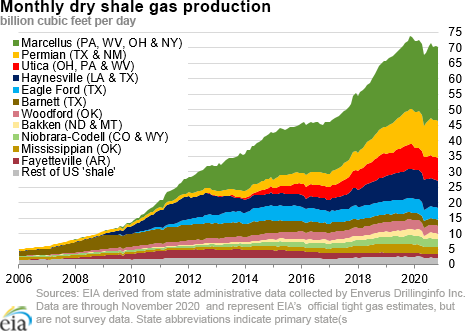In the News:
U.S. natural gas production will likely fall in 2021 and rise in 2022
In its January Short-Term Energy Outlook (STEO), EIA estimates that annual U.S. marketed gas production for 2021 will fall 2% and average 96.2 billion cubic feet per day (Bcf/d). However, in 2022, EIA estimates that natural gas production will rise by 2% compared with year-ending 2021 production of 98.2 Bcf/d, accompanied by rising natural gas prices. The United States set annual natural gas production records in 2018 and 2019, largely based on increased drilling in shale and tight oil formations. This increased production led to higher volumes of natural gas in storage and a corresponding decrease in natural gas prices. In 2020, the supply and demand contraction as a result of the COVID-19 pandemic resulted in marketed natural gas production decreasing by 2% from 2019 levels.
The January STEO also forecasts associated gas production from oil wells in the Permian Basin to fall because of a lower West Texas Intermediate (WTI) crude oil price and reduced drilling activity in the early months of 2021. As the WTI price increases, associated gas production will likely rise with it. Natural gas production from predominantly natural gas regions such as the Appalachia Basin is closely tied to the Henry Hub price. EIA estimates that the Henry Hub price will gradually rise from an average $2.03 per million British thermal units (MMBtu) in 2020 to more than $3.00/MMBtu in 2022. The increase in the Henry Hub price is likely to result in a rise in natural gas production in Appalachia. However, natural gas production in Appalachia may reach its takeaway capacity constraints in 2021 if the Mountain Valley Pipeline (MVP), scheduled to enter service in late 2021, is delayed. MVP is the only active pipeline project planned to come online in 2021 that will add significant takeaway capacity from the Appalachia region.
A recent Today in Energy article provides more information about recent natural gas and crude oil production trends.
Overview:
(For the week ending Wednesday, January 13, 2021)
- Natural gas spot prices rose at most locations this report week (Wednesday, January 6 to Wednesday, January 13). The Henry Hub spot price rose from $2.70 per million British thermal units (MMBtu) last Wednesday to $2.75/MMBtu yesterday.
- At the New York Mercantile Exchange (Nymex), the price of the February 2021 contract increased 1¢, from $2.716/MMBtu last Wednesday to $2.727/MMBtu yesterday. The price of the 12-month strip averaging February 2021 through January 2022 futures contracts remained the same Wednesday to Wednesday at $2.841/MMBtu.
- The net withdrawals from working gas totaled 134 billion cubic feet (Bcf) for the week ending January 8. Working natural gas stocks totaled 3,196 Bcf, which is 4% more than the year-ago level and 7% more than the five-year (2016–2021) average for this week.
- The natural gas plant liquids composite price at Mont Belvieu, Texas, rose by 50¢/MMBtu, averaging $7.01/MMBtu for the week ending January 13. The prices of ethane, isobutane, natural gasoline, propane, butane all rose, by 5%, 7%, 8%, 9%, and 9%, respectively.
- According to Baker Hughes, for the week ending Tuesday, January 5, the natural gas rig count increased by 1 to 84. The number of oil-directed rigs rose by 8 to 275. The total rig count increased by 9, and it now stands at 360.
Prices/Supply/Demand:
Prices rise at most locations. This report week (Wednesday, January 6 to Wednesday, January 13), the Henry Hub spot price traded within a relatively narrow range and rose 5¢ from $2.70/MMBtu last Wednesday to $2.75/MMBtu yesterday. Temperatures in the Lower 48 states were cooler than normal across the southwest, with snow in central Texas. Temperatures were warmer than normal across the rest of the country, especially the Great Plains. At the Chicago Citygate, the price increased 5¢ from $2.58/MMBtu last Wednesday to $2.63/MMBtu yesterday.
California prices are mixed. The price at SoCal Citygate in Southern California decreased 22¢ from $3.71/MMBtu last Wednesday to $3.49/MMBtu yesterday with net injections into underground storage yesterday and today. The price at PG&E Citygate in Northern California rose 11¢, up from $3.56/MMBtu last Wednesday to $3.67/MMBtu yesterday.
Northeast prices rise. At the Algonquin Citygate, which serves Boston-area consumers, the price increased by $1.48 from a low of $2.99/MMBtu last Wednesday to a high of $4.47/MMBtu yesterday. According to S&P Global, relatively large declines in natural gas storage levels in the New England area may be contributing to recent upward price pressure in the region, At the Transcontinental Pipeline Zone 6 trading point for New York City, the price increased 2¢ from a low of $2.80/MMBtu last Wednesday to $2.82/MMBtu yesterday.
The Tennessee Zone 4 Marcellus spot price increased 10¢ from $2.30/MMBtu last Wednesday to $2.40/MMBtu yesterday. The price at Dominion South in southwest Pennsylvania rose 11¢ from $2.32/MMBtu last Wednesday to $2.43/MMBtu yesterday.
Permian Basin discount to the Henry Hub narrows. The price at the Waha Hub in West Texas, which is located near Permian Basin production activities, averaged a low of $2.52/MMBtu last Wednesday, 18¢/MMBtu lower than the Henry Hub price. Yesterday, the price at the Waha Hub averaged $2.61/MMBtu, 14¢/MMBtu lower than the Henry Hub price. S&P Global reports that natural gas production in the Permian has fallen about 500 million cubic feet per day (MMcf/d) over the past month, which along with below-average temperatures in East Texas, has contributed to higher prices at the Waha Hub.
Supply falls because of declines in dry natural gas production. According to data from IHS Markit, the average total supply of natural gas fell by 0.8% compared with the previous report week. Dry natural gas production decreased by 0.9% compared with the previous report week. Average net imports from Canada increased by 2.0% from last week.
Demand rises in most sectors. Total U.S. consumption of natural gas rose by 5.7% compared with the previous report week, according to data from IHS Markit. Natural gas consumed for power generation climbed by 9.6% week over week. In the residential and commercial sectors, consumption increased by 5.2%. Industrial sector consumption increased by 2.2% week over week. Natural gas exports to Mexico increased 8.3%. Natural gas deliveries to U.S. liquefied natural gas (LNG) export facilities (LNG pipeline receipts) averaged 10.8 billion cubic feet per day (Bcf/d), or 0.22 Bcf/d lower than last week. Beginning on January 12, scheduled maintenance at the Sinton Compressor Station along Cheniere’s Corpus Christie Pipeline reduced flows to Corpus Christi LNG by approximately 128 MMcf/d, according to Natural Gas Intelligence.
U.S. LNG exports decrease week over week. Sixteen LNG vessels (seven from Sabine Pass, three each from Cameron and Corpus Christi, two from Freeport, and one from Cove Point) with a combined LNG-carrying capacity of 59 Bcf departed the United States between January 7 and January 13, 2021, according to shipping data provided by Bloomberg Finance, L.P.
Storage:
The net withdrawals from storage totaled 134 Bcf for the week ending January 8, compared with the five-year (2016–2021) average net withdrawals of 161 Bcf and last year's net withdrawals of 91 Bcf during the same week. Working natural gas stocks totaled 3,196 Bcf, which is 218 Bcf more than the five-year average and 126 Bcf more than last year at this time.
According to The Desk survey of natural gas analysts, estimates of the weekly net change to working natural gas stocks ranged from net withdrawals of 117 Bcf to 141 Bcf, with a median estimate of 128 Bcf.
The average rate of withdrawals from storage is 3% lower than the five-year average so far in the withdrawal season (November through March). If the rate of withdrawals from storage matched the five-year average of 14.3 Bcf/d for the remainder of the withdrawal season, the total inventory would be 2,024 Bcf on March 31, which is 218 Bcf higher than the five-year average of 1,806 Bcf for that time of year.
More storage data and analysis can be found on the Natural Gas Storage Dashboard and the Weekly Natural Gas Storage Report.
See also:
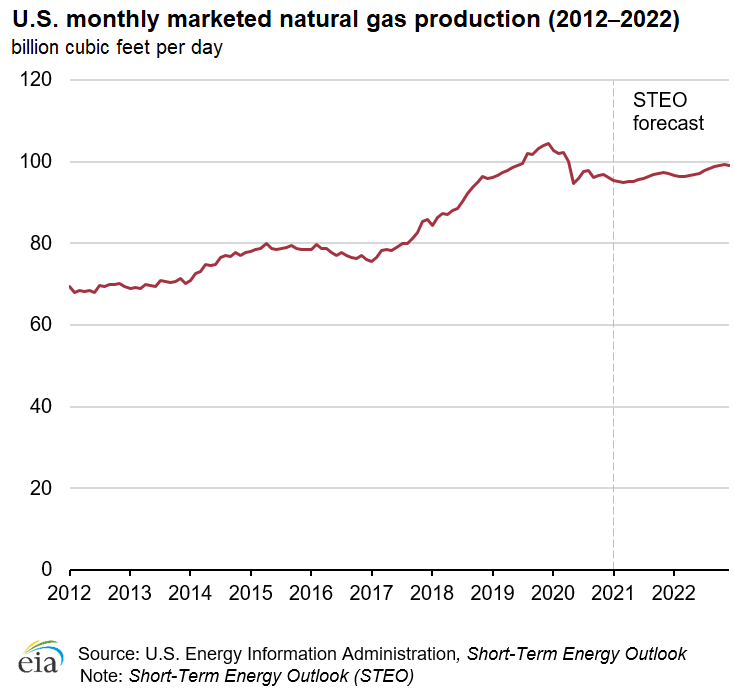
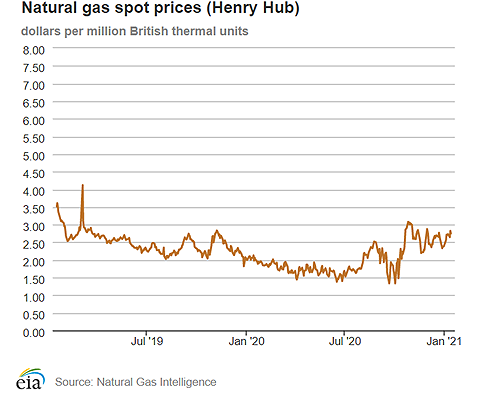
| Spot Prices ($/MMBtu) | Thu, 07-Jan |
Fri, 08-Jan |
Mon, 11-Jan |
Tue, 12-Jan |
Wed, 13-Jan |
|---|---|---|---|---|---|
| Henry Hub |
2.73 |
2.73 |
2.65 |
2.83 |
2.75 |
| New York |
2.80 |
2.87 |
2.92 |
2.90 |
2.82 |
| Chicago |
2.64 |
2.61 |
2.56 |
2.73 |
2.63 |
| Cal. Comp. Avg.* |
3.10 |
3.05 |
3.02 |
3.16 |
3.08 |
| Futures ($/MMBtu) | |||||
| February contract | 2.729 |
2.700 |
2.747 |
2.753 |
2.727 |
| March contract |
2.691 |
2.656 |
2.703 |
2.707 |
2.689 |
| *Avg. of NGI's reported prices for: Malin, PG&E Citygate, and Southern California Border Avg. | |||||
| Source: NGI's Daily Gas Price Index | |||||
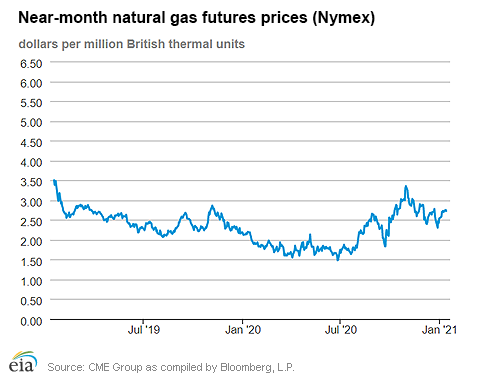
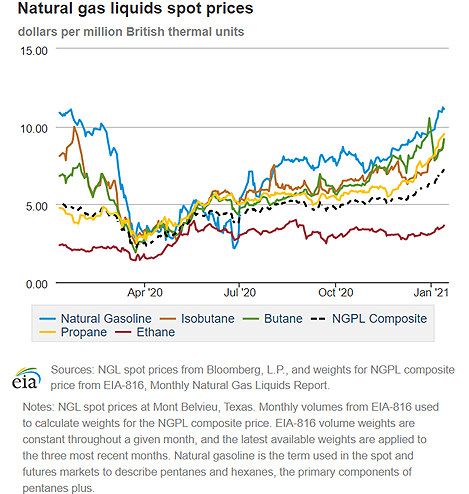
| U.S. natural gas supply - Gas Week: (1/7/21 - 1/13/21) | |||
|---|---|---|---|
Average daily values (Bcf/d): |
|||
this week |
last week |
last year |
|
| Marketed production | 101.9 |
102.9 |
107.1 |
| Dry production | 90.3 |
91.1 |
95.0 |
| Net Canada imports | 6.0 |
5.9 |
3.9 |
| LNG pipeline deliveries | 0.2 |
0.3 |
0.2 |
| Total supply | 96.5 |
97.2 |
99.1 |
|
Source: IHS Markit | |||
| U.S. natural gas consumption - Gas Week: (1/7/21 - 1/13/21) | |||
|---|---|---|---|
Average daily values (Bcf/d): |
|||
this week |
last week |
last year |
|
| U.S. consumption | 94.4 |
89.3 |
93.8 |
| Power | 29.4 |
26.8 |
28.8 |
| Industrial | 25.0 |
24.5 |
25.3 |
| Residential/commercial | 40.0 |
38.0 |
39.7 |
| Mexico exports | 5.5 |
5.1 |
5.2 |
| Pipeline fuel use/losses | 7.7 |
7.5 |
8.1 |
| LNG pipeline receipts | 10.8 |
11.0 |
8.3 |
| Total demand | 118.4 |
113.0 |
115.4 |
|
Source: IHS Markit | |||
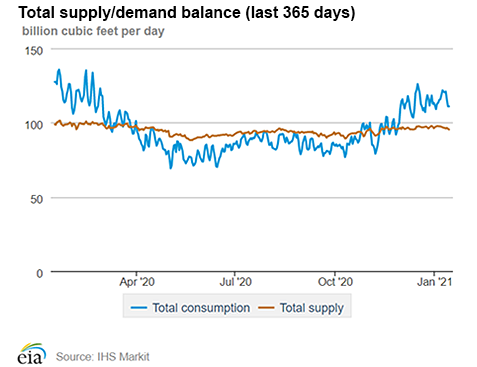
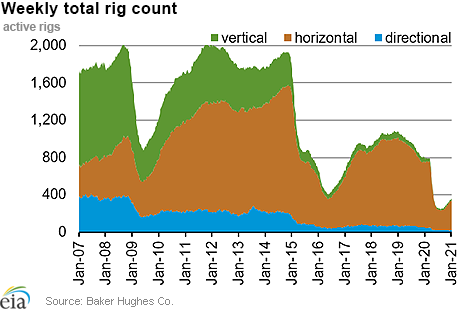
| Rigs | |||
|---|---|---|---|
Tue, January 05, 2021 |
Change from |
||
last week |
last year |
||
| Oil rigs | 275 |
3.0% |
-58.3% |
| Natural gas rigs | 84 |
1.2% |
-29.4% |
| Note: Excludes any miscellaneous rigs | |||
| Rig numbers by type | |||
|---|---|---|---|
Tue, January 05, 2021 |
Change from |
||
last week |
last year |
||
| Vertical | 18 |
5.9% |
-52.6% |
| Horizontal | 320 |
2.2% |
-54.2% |
| Directional | 22 |
4.8% |
-51.1% |
| Source: Baker Hughes Co. | |||
| Working gas in underground storage | ||||
|---|---|---|---|---|
Stocks billion cubic feet (Bcf) |
||||
| Region | 2021-01-08 |
2021-01-01 |
change |
|
| East | 726 |
765 |
-39 |
|
| Midwest | 879 |
923 |
-44 |
|
| Mountain | 188 |
196 |
-8 |
|
| Pacific | 278 |
282 |
-4 |
|
| South Central | 1,126 |
1,163 |
-37 |
|
| Total | 3,196 |
3,330 |
-134 |
|
|
Source: Form EIA-912, Weekly Underground Natural Gas Storage Report | ||||
| Working gas in underground storage | |||||
|---|---|---|---|---|---|
Historical comparisons |
|||||
Year ago (1/8/20) |
5-year average (2016-2020) |
||||
| Region | Stocks (Bcf) |
% change |
Stocks (Bcf) |
% change |
|
| East | 727 |
-0.1 |
697 |
4.2 |
|
| Midwest | 861 |
2.1 |
829 |
6.0 |
|
| Mountain | 162 |
16.0 |
165 |
13.9 |
|
| Pacific | 238 |
16.8 |
248 |
12.1 |
|
| South Central | 1,082 |
4.1 |
1,040 |
8.3 |
|
| Total | 3,070 |
4.1 |
2,978 |
7.3 |
|
| Source: Form EIA-912, Weekly Underground Natural Gas Storage Report | |||||
| Temperature – heating & cooling degree days (week ending Jan 07) | ||||||||
|---|---|---|---|---|---|---|---|---|
HDD deviation from: |
CDD deviation from: |
|||||||
| Region | HDD Current |
normal |
last year |
CDD Current |
normal |
last year |
||
| New England | 221 |
-47 |
18 |
0 |
0 |
0 |
||
| Middle Atlantic | 209 |
-47 |
17 |
0 |
0 |
0 |
||
| E N Central | 236 |
-55 |
29 |
0 |
0 |
0 |
||
| W N Central | 262 |
-53 |
36 |
0 |
0 |
0 |
||
| South Atlantic | 142 |
-38 |
15 |
7 |
0 |
-1 |
||
| E S Central | 147 |
-40 |
16 |
0 |
-2 |
0 |
||
| W S Central | 118 |
-22 |
26 |
0 |
-3 |
0 |
||
| Mountain | 213 |
-24 |
10 |
0 |
0 |
0 |
||
| Pacific | 112 |
-13 |
13 |
0 |
0 |
0 |
||
| United States | 185 |
-38 |
21 |
1 |
-1 |
0 |
||
|
Note: HDD = heating degree day; CDD = cooling degree day Source: National Oceanic and Atmospheric Administration | ||||||||
Average temperature (°F)
7-day mean ending Jan 07, 2021
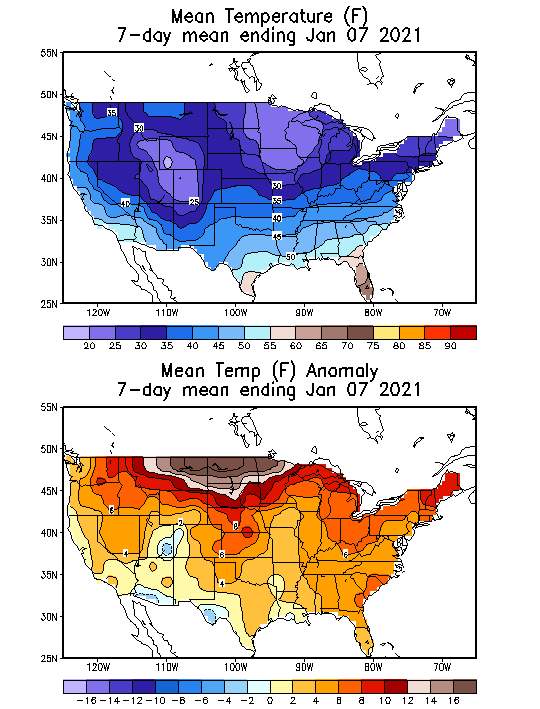
Source: National Oceanic and Atmospheric Administration
Deviation between average and normal (°F)
7-day mean ending Jan 07, 2021

Source: National Oceanic and Atmospheric Administration

